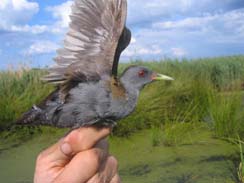Habitat use and segregation of rails of the genus Porzana
All seven species of rail occur on the restored and re-wetted areas in the valley of the river Peene. This includes the three species of Porzana, P. porzana, P. parva and P. pusilla. The latter was thought to be extinct in Germany. We are interested in the habitat requirements of these three species during the breeding season in order to understand how these closely related species can co-exist. We investigate abiotic and biotic characteristics of habitats as well as spatial and temporal use of territories, intra- and interspecific territorial behavior, and social interactions. In this context, we have an additional focus on the more common Water Rail, which probably also interacts with the Porzana species. These investigations are also complemented by molecular approaches in order to answer population genetic and demographic questions. The ultimate goal is the elaboration of conservation and management measures aiming at the permanent establishment of these rail populations.
Scientists involved: Dipl.-Biol. Alexander Eilers, Dr. Angela Schmitz, Dipl.-Biol. Benjamin Herold, Dr. Martin Haase
Financing:Brehm Fonds für den internationalen Vogelschutz, Bonn
Plumage coloration in phylogenetic and evolutionary analyses
Die Färbung des Gefieders von Vögeln spielt bei vielen Arten eine maßgebliche Rolle bei der Partnerwahl und steht somit unter sexueller Selektion. Die Gefiederfärbung hat daher bei der Artbildung eine wichtige Funktion, was seinen Niederschlag auch in der Taxonomie findet. So wichtig das Gefieder in der Unterscheidung von Arten ist, so schwierig war es bisher, diesen Merkmalskomplex für die phylogenetische Analyse heranzuziehen. Dr. Angela Schmitz hat eine Methode entwickelt, objektiv gemessene Farbspektraldaten für kladistische Analysen zu kodieren. Moderne phylogenetische Analysen beruhen heute maßgeblich auf genetischen Daten. Allerdings stellte es sich bei zahlreichen Vogelgruppen heraus, dass genetische Standard-Marker wie mitochondrielle Gene nur wenig zwischenartliche Variabilität zeigen und daher für die Ermittlung von Verwandtschaftsverhältnissen auf dem Artniveau nur bedingt brauchbar sind. V.a. für Gruppen, bei denen die Gefiederfärbung offensichtlich eine bedeutende Rolle in der Speziation spielt, könnten daher Farbspektraldaten eine wichtige Ergänzung zu genetischen Daten darstellen. Dies wird anhand von Analysen von genetischen und Farbspektraldaten von Kolibris untersucht.
Mitarbeiter: Dr. Angela Schmitz, Dr. Martin Haase
Finanzierung: Deutsche Forschungsgemeinschaft; Alexander Koenig Foundation, Bonn; Brehm Fonds für den internationalen Vogelschutz, Bonn; Short-Term visitor appointment, Smithsonian Institution, Washington DC; Collections’ Study Grant, American Museum of Natural History, New York; Jessup Grant, Academy of Natzral Sciences, Philadelphia; SYNTHESYS (the European Union-funded Integrated Infrastructure Initiative grant)


